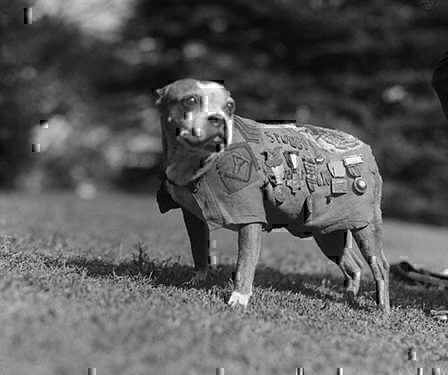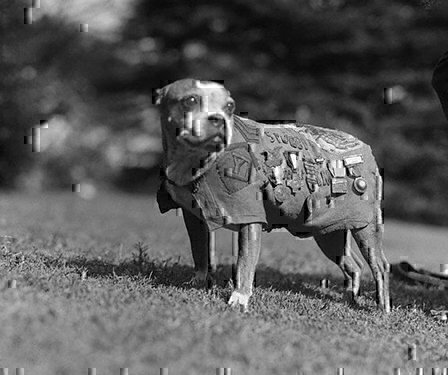SPONSORED
HONORING OUR SERVICE DOGS
Revered for centuries for their unwavering bravery and loyalty, dogs have served alongside the men and women of the Armed Forces for most of American history. They started off as mascots and companions, but the military eventually saw their value in service and began training them to help in combat and daily operations.
One dog was integral in that decision: Sergeant Stubby of the 102nd Infantry, Yankee Division. Although historians aren’t certain of his breed, many believe he may have been a mix between a bull terrier and a Boston terrier. Stubby made a successful transition from mascot to hero during World War I. He alerted his unit to a surprise mustard gas attack; he comforted the wounded on the battlefield; and he once captured a German soldier and held him captive by the seat of his pants until help could arrive.
Sergeant Stubby showing off his medals. Source: Wikipedia.
Stubby helped pave the way for many more military dogs to come. March 13, 1942 marks the official birthday of the United States K9 Corps, and now there’s a growing movement to recognize that anniversary as K9 Veterans’ Day. The push for recognition began in 2009 thanks to the late Joseph Smith, a retired military dog handler. The cause has been taken up by the Kennel Club of Fort Atkins, among others, and they’ve started a petition to establish it as an official holiday. You can sign it here.
There’s no doubting the loyalty and devotion of our four-legged counterparts. They’re celebrated for putting themselves in harm’s way, ready to make the ultimate sacrifice to protect their handlers, their fellow service members and everyone in America.
There are about 2,500 dogs active in the modern military. About 700 of them are deployed overseas. They utilize their natural abilities, including their powerful sense of smell, to detect weapons, bombs and gases more accurately than any modern machinery. The military makes no bones about it: They’re looking for extraordinary dogs. That’s why only about 50 percent of them make it through training. On K9 Veterans’ Day, we salute these special dogs and their handlers, and celebrate the connection they share.
THOUSANDS OF UNIQUE STORIES
Stubby’s story is just one of many. While we don’t have time to tell them all, I saw one recently that really stuck out at me.
The Daily Mail reported a story in February about Sergeant Dave Heyhoe of the Royal Army Veterinary Corps in the UK and Treo, his black lab. The two toured Afghanistan together, where Treo was used to search for weapons and explosives. Treo is credited with saving the lives of potentially dozens of British troops, most notably when he uncovered a chain of explosives buried by the Taliban in Helmand Province.
After Treo’s time in service was over, he was sent home to live with Heyhoe’s family. The dog passed in October of 2015 at the age of 14, and that’s where things get interesting. Like many handlers, Heyhoe decided to get a tattoo to immortalize his companion. But here’s the catch: He had the tattoo artist mix some of the dog’s ashes into the ink. Complete with a paw print and a poem, Treo’s memory will live on with Heyhoe forever. For more information, and to see photos, check out the article on the Daily Mail.
FEELING GENEROUS?
In 2000, President Clinton passed “Robby’s Law,” which granted handlers priority in adopting K9 veterans when they return home. If the handler can’t take them, the dogs are then offered to police or civilian families. There are plenty of nonprofit organizations that help bring our working dogs home and help them find loving families. Many others train service dogs to help disabled veterans. Here are a few notable charities if you’re interested in helping out.
- American Humane Association: The country’s first national humane organization, founded in 1877. The Lois Pope LIFE Center for Military Affairs works to rescue and rehabilitate our K9 veterans, and reunite them with their handlers back home.
- Patriot PAWS: Their mission is to train service dogs and donate them at no cost to disabled American veterans to help with physical mobility and emotional independence.
- Warrior Dog Foundation: Another group that works to bring dogs safely home after their time in the service is over. They have a state-of-the-art kennel facility and focus on rehabilitation for the dogs to get them ready for their forever homes.
- Mission K9 Rescue: Their mission is to rescue, reunite, re-home, rehabilitate and repair working dogs. They’re based out of Houston with satellite offices in San Antonio and Los Angeles.
- Pets for Patriots: They rescue pets from shelters and work to unite them with military veterans. They rescue many dogs from death row at high-kill shelters.
- US War Dogs Association: Not only do they help with adoption and support for returning troops, but they’re also dedicated to education and exposure with a traveling museum exhibit celebrating the history of service dogs.
This story is presented by Pioneer Services, the military division of MidCountry Bank, which has provided award-winning financial education to the men and women of the Armed Forces for over 30 years.
*This article is sponsored by Pioneer Services, a paid client of Military Spouse.









